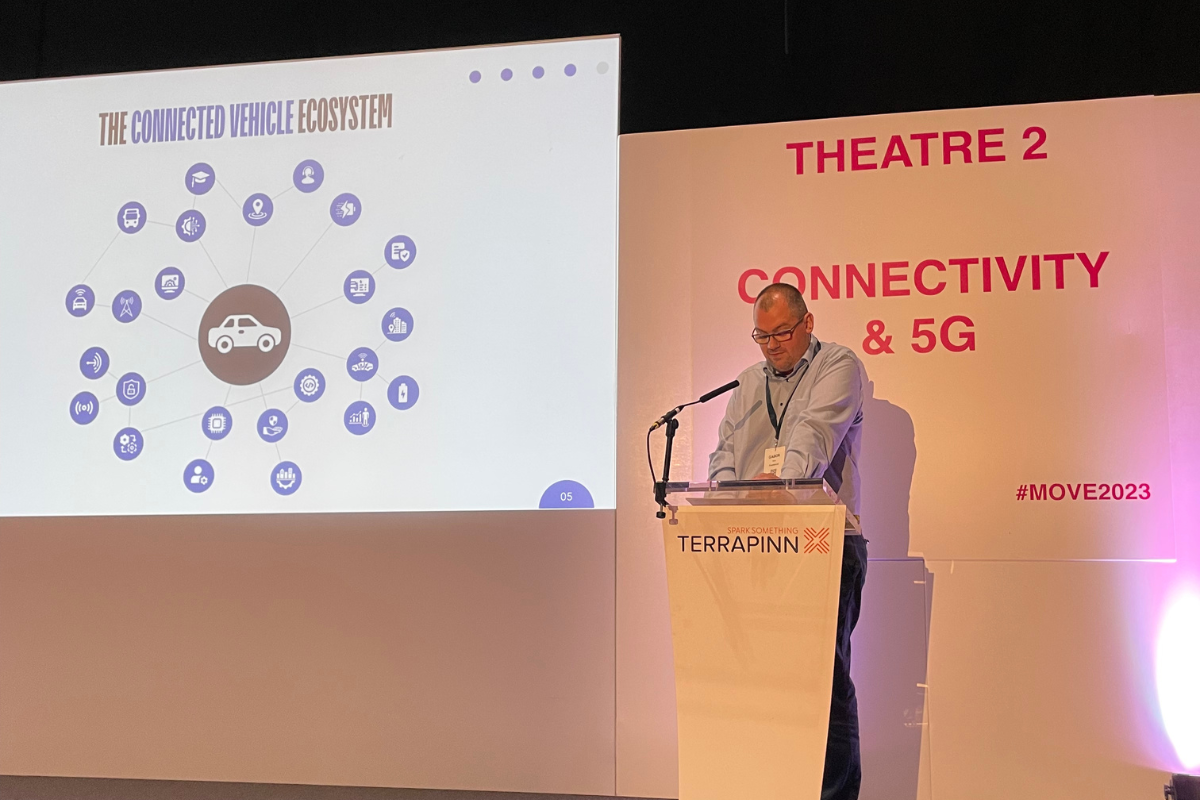MOVE 2023 London: How Enterprise Architecture Drives Successful Adaptation in the Connected Vehicle Ecosystem
The MOVE 2023 mobility exhibition in London provided a platform for industry experts to share insights into the future of transportation. One notable presentation came from Gábor Sulok, our Senior Consultant, who explored how enterprise architecture drives the successful adaptation of connected vehicle ecosystems. This post examines the critical role of enterprise architecture in shaping the future of mobility.
The Connected Vehicle Ecosystem:
The connected vehicle ecosystem refers to a network of interconnected components, technologies, and stakeholders that enable advanced vehicle connectivity and communication. This ecosystem enhances the driving experience, introduces new functionalities, and offers benefits such as improved safety, convenience, and efficiency in the automotive industry. However, as the adoption of connected vehicle technologies increases, so does the complexity of the ecosystem. Integration among different players becomes crucial for seamless communication, interoperability, and compatibility.

The Role of Enterprise Architecture:
Enterprise architecture (EA) plays a pivotal role in driving the successful adaptation of connected vehicle ecosystems. By providing a holistic view of an organization’s structure, processes, systems, and technologies, EA ensures that business strategy aligns with technology initiatives. It helps identify gaps, redundancies, and inefficiencies within the organization, creating a roadmap for digital transformation.
Key Benefits of Enterprise Architecture:
- Alignment with Business: EA aligns technology initiatives with business objectives, ensuring that the connected vehicle ecosystem supports the organization’s strategic goals.
- Standardization: EA establishes standards, interfaces, and frameworks for interoperability, enabling seamless integration of different components within the ecosystem.
- Cost Saving: By identifying redundancies and inefficiencies, EA helps organizations optimize resources and reduce costs.
- Decision-making: EA provides a structured approach to decision-making, considering capabilities, dependencies, and opportunities within the connected vehicle ecosystem.
- Innovation: EA promotes innovation by encouraging collaboration and fostering partnerships among stakeholders in the ecosystem.
Adapting to the Connected Vehicle Ecosystem:
The connected vehicle ecosystem welcomes a wide range of industries to participate alongside core automotive companies. Enterprise architecture plays a vital role in supporting the adaptation of companies in different industries and at various levels of development and maturity. By providing a structured approach and a holistic view, EA enables organizations to align their strategies, processes, and technologies with the requirements of the ecosystem. This includes integrating connectivity technologies into older vehicles, addressing legacy systems, retrofitting, managing technical complexities, and ensuring resilience and cybersecurity.
Challenges and Opportunities:
The adaptation to the connected vehicle ecosystem comes with its own set of challenges. Reliable and widespread infrastructure, data security, standardization, regulatory and legal frameworks, consumer acceptance and adoption, liability and insurance concerns, technical complexity, and the fast evolution of technologies are some of the key challenges that organizations need to address. Enterprise architecture helps tackle these challenges by providing a strategic framework, establishing governance processes, facilitating decision-making, and ensuring compliance with industry standards.
Embracing Autonomous Driving:
Autonomous driving represents a significant transformation within the connected vehicle ecosystem. It requires a comprehensive approach across all EA domains. From defining strategic objectives and business models for autonomous driving to identifying data sources, developing algorithms, selecting technologies, ensuring compliance, and implementing robust security frameworks, EA plays a pivotal role in enabling the adoption of autonomous driving capabilities.
Supporting Enterprise Architecture:
To effectively implement enterprise architecture, organizations can leverage dedicated EA tools, models, and repositories. These tools provide centralized platforms for documentation, analysis, and visualization of architectural artifacts, enabling modeling capabilities, impact analysis, and reporting functionalities. Standardized EA models like TOGAF or ArchiMate provide a shared language for communication and collaboration. Additionally, implementing EA governance frameworks helps define roles, responsibilities, decision-making processes, and align business and IT activities.
Tailoring Adaptation to Different Environments:
Enterprise architecture acknowledges that organizations vary in size, structure, and maturity levels. Adaptation to the connected vehicle ecosystem should be tailored to the specific needs and requirements of each organization. While large companies may face complex organizational structures and regulations, startups and smaller businesses enjoy more freedom. Regardless of size, EA provides a structured approach to guide organizations through the adaptation process, ensuring alignment with business objectives and efficient utilization of resources.
Our participation in MOVE 2023 London and our presentation on how enterprise architecture drives successful adaptation in the connected vehicle ecosystem provided valuable insights into the crucial role of EA in shaping the future of mobility. By leveraging EA principles, frameworks, and methodologies, organizations can effectively navigate the complexities of the connected vehicle ecosystem, unlock new business opportunities, enhance safety and efficiency, and drive innovation. As the mobility landscape continues to evolve, the strategic implementation of enterprise architecture will remain essential for organizations seeking to thrive in the era of connected vehicles.
-
© Copyright 2023. Bdat Solutions. All rights reserved!

